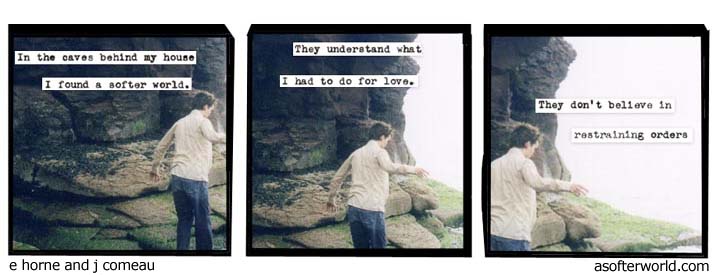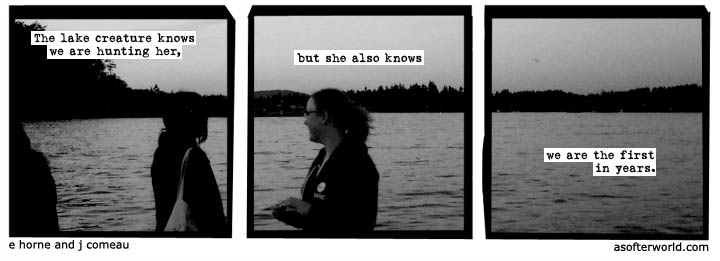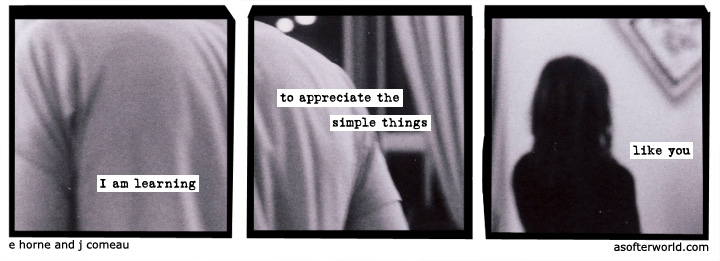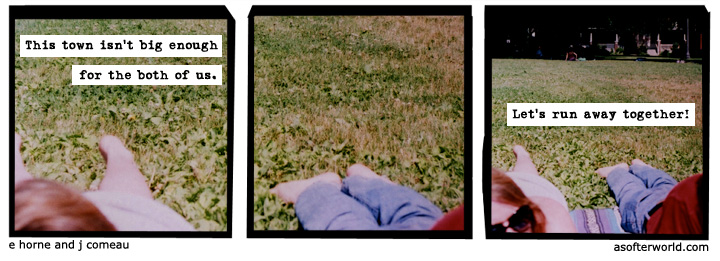A Softer World is a completely different webcomics animal than the kind we’ve previously offered up for examination in this monthly column. There is no ongoing narrative here, no clear cut protagonists and antagonists, no word balloons, no worldbuilding. There are only the words, and the photographs these words run across. Created by Emily Horne and Joey Comeau, A Softer World is the melancholic corner of the internet. It somehow exists as both unflinchingly raw in the way it handles depression, fear, and the more unsettling aspects of life, while also imbuing these meditations with a sense of humor that seems to suggest that laughing about these things is the first step to really thinking about them, and coming to terms with them.
This duality isn’t the only thing that makes A Softer World a unique viewpoint in the webcomics landscape, its entire construction does, as well. ASW comics are usually a series of three panels, with each panel either part of one photograph, or each a highlighted part of one photograph, enlarged to show detail or to reveal something that interacts with the words. And the words here? Arguably the best part of the comic. Often times an ASW comic will only have one sentence written across the photograph, broken up into sections within the panels in a font that’s reminiscent of typewriter scrawl. The construction is simple, and though it doesn’t sound like it should be all that effective or interesting—not enough, at least, for A Softer World to become a long running comic that’s inspired countless imitations—it employs a one-two punch of direct sincerity and strange humor that makes ASW such a breath of fresh air.
The real genius of A Softer World (and the reason for its staying power, I’d argue) is the exceptional timing in each panel. Listen, I know that timing doesn’t sound like a thing that can happen with a webcomic whose only two elements are a single sentence and the photograph it’s splashed across, but that timing is absolutely essential to driving home the emotional resonance that A Softer World is so well known for. Horne and Comeau are careful in how they break apart their sentences, often times leaving a panel blank in order to generate pauses where they’re needed, or to change the meaning of the sentence for the moment, before flipping the idea on its head in the last panel. These sentences range from simple and original observations about life, to clever wordplay, to surreal (and horror-influenced) scenarios that would never occur in reality, and to everything in between. And though the pacing of this comics series is limited to three panels and a more simple structure, it just highlights how important good timing is in the comics medium in general.
An important part of the effectiveness of A Softer World’s timing comes from the use of alternative text, a hidden reveal usually used as a fourth panel, or a coda, to the existing three. Alt-text (that thing that happens when you hover your mouse over an image) is a uniquely internet way of communicating information, and though you can get nearly all ASW comics as print-outs to adorn your college dorm with, the alt-text is left on your computer (though the alt-text is often used as the comic strip’s title, as well). More often than not, this alt-text completely changes the meaning of the comic you just read. It’s used to enhance a punchline, to bring home an especially gut-wrenching moment of emotional honesty, or to warp the comic into a different thing entirely.
For instance, in the below example (ASW #1173), “I am learning / to appreciate the simple things / like you” suggests that the speaker (the “I”) and the subject (the “you”) are in some sort of relationship, ending the strip with a positive tone. But then you get to the alt-text: “taught me.” Immediately, the meaning of the comic changes. The phrase that we thought was complete was in fact just a fragment, with the alt-text completing the sentence. The tone shifts after the revelation of the alt-text, curdling the otherwise more romantic notions of the original comic, leaving an implication that the “I” and the “you” are no longer together, and that the “I” is trying hard to take advice from the now-gone “you.” But still, the absolute meaning of the strip is unclear. Is “you” an ex-lover of “I”? Or perhaps “you” is a relative that has passed away, or a friend that “I” has had a falling out with. Was it the inability of “I” to appreciate the simple things in life that pushed “you” away? The ambiguity in these narratives are never irritating, instead they elevate the comic into not just one specific story, but an observation about life in general that can apply to anyone reading. These ambiguities combine with the timing to elicit an emotional response that has everything to do with the simplicity of the series.
The photography that acts as every panel background brings a depth to the work that can be missed at first glance. Like the phrases that make up the ‘story’ of ASW, the interplay between the words and the photography is varied. Sometimes an image is paired with a phrase to evoke a certain feeling by playing off iconography we’re all familiar with. In ASW #407, the first panel is of a black cat’s head, angled so it seems the cat is looking out across the remaining two panels, side-eying the text that reads: “the dark arts are just like every other drug. / not so interesting after you find out that your mom does it. / [Alt-text: Jesus, mom. I have friends coming over.]” Black cats are a symbol that are often associated with the occult, with witches, with magic. By using the cat in the first panel, Horne and Comeau forecast the allusion to the ‘dark arts’ in a subtle way, thereby setting the stage for the story that follows.
Sometimes the relationship between the image and the narrative is harder to place, but this ambiguity acts much like the ambiguity of the stories themselves, by elevating the comic and opening it up to various different levels of interpretation. In ASW #635, for example, the image is of two people laying out in the sun on a blanket spread across a grassy lawn. In the first and second panels we’re introduced to these people’s feet, with the third panel being a wider shot of the entire photograph, showing clearly how closely these two people are sitting together, though their faces are never entirely clear. “This town isn’t big enough for the both of us,” the first panel reads, while the third panel concludes, “Let’s run away together!” It’s a play on the otherwise serious and now cliché phrase, “This town isn’t big enough for the two of us,” that often precedes violence of some kind. The substitution of violence with something non-violent is evident in the alt-text as well: “Let’s join a street gang! Is NASA recruiting?” The setting of the photograph implies that the two people within it are sharing this conversation, without explicitly stating that they are. It leaves the interpretation of the relationship between the text and the image open to the reader, thereby creating a different resonance in each person, and making this series a highly personal read.
The success of A Softer World lies within its simplicity, and stems from Horne and Comeau’s rejection of a traditional narrative for their webcomic. Though ASW has inspired countless mash-ups and imitations, the original remains a unique approach to telling stories with comics.
Read A Softer World at asofterworld.com and be sure to check out Christina and Joe’s previous Webcomics Field Guides!





